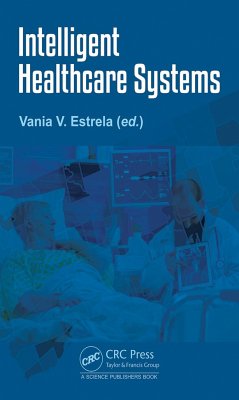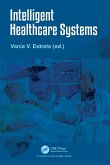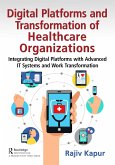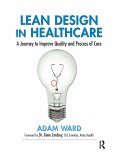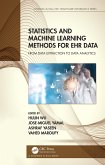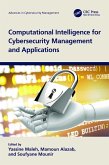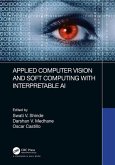Intelligent Healthcare Systems
Herausgeber: Estrela, Vania V
Intelligent Healthcare Systems
Herausgeber: Estrela, Vania V
- Gebundenes Buch
- Merkliste
- Auf die Merkliste
- Bewerten Bewerten
- Teilen
- Produkt teilen
- Produkterinnerung
- Produkterinnerung
The book follows a medical cyber-physical systems' paradigm to handle the dimensionality conundrum stemming from image acquisition, image modality/resolution/representation, subspace decomposition, compressed sensing, and communications constraints.
Andere Kunden interessierten sich auch für
![Intelligent Healthcare Systems Intelligent Healthcare Systems]() Intelligent Healthcare Systems74,99 €
Intelligent Healthcare Systems74,99 €![Artificial Intelligence in Cyber-Physical Systems Artificial Intelligence in Cyber-Physical Systems]() Artificial Intelligence in Cyber-Physical Systems132,99 €
Artificial Intelligence in Cyber-Physical Systems132,99 €![Digital Platforms and Transformation of Healthcare Organizations Digital Platforms and Transformation of Healthcare Organizations]() Rajiv KapurDigital Platforms and Transformation of Healthcare Organizations53,99 €
Rajiv KapurDigital Platforms and Transformation of Healthcare Organizations53,99 €![Lean Design in Healthcare Lean Design in Healthcare]() Adam WardLean Design in Healthcare48,99 €
Adam WardLean Design in Healthcare48,99 €![Statistics and Machine Learning Methods for EHR Data Statistics and Machine Learning Methods for EHR Data]() Statistics and Machine Learning Methods for EHR Data165,99 €
Statistics and Machine Learning Methods for EHR Data165,99 €![Computational Intelligence for Cybersecurity Management and Applications Computational Intelligence for Cybersecurity Management and Applications]() Computational Intelligence for Cybersecurity Management and Applications149,99 €
Computational Intelligence for Cybersecurity Management and Applications149,99 €![Applied Computer Vision and Soft Computing with Interpretable AI Applied Computer Vision and Soft Computing with Interpretable AI]() Applied Computer Vision and Soft Computing with Interpretable AI103,99 €
Applied Computer Vision and Soft Computing with Interpretable AI103,99 €-
-
-
The book follows a medical cyber-physical systems' paradigm to handle the dimensionality conundrum stemming from image acquisition, image modality/resolution/representation, subspace decomposition, compressed sensing, and communications constraints.
Hinweis: Dieser Artikel kann nur an eine deutsche Lieferadresse ausgeliefert werden.
Hinweis: Dieser Artikel kann nur an eine deutsche Lieferadresse ausgeliefert werden.
Produktdetails
- Produktdetails
- Verlag: Taylor & Francis Ltd
- Seitenzahl: 388
- Erscheinungstermin: 4. August 2023
- Englisch
- Abmessung: 235mm x 158mm x 26mm
- Gewicht: 710g
- ISBN-13: 9781032052724
- ISBN-10: 1032052724
- Artikelnr.: 68101886
- Herstellerkennzeichnung
- Libri GmbH
- Europaallee 1
- 36244 Bad Hersfeld
- gpsr@libri.de
- Verlag: Taylor & Francis Ltd
- Seitenzahl: 388
- Erscheinungstermin: 4. August 2023
- Englisch
- Abmessung: 235mm x 158mm x 26mm
- Gewicht: 710g
- ISBN-13: 9781032052724
- ISBN-10: 1032052724
- Artikelnr.: 68101886
- Herstellerkennzeichnung
- Libri GmbH
- Europaallee 1
- 36244 Bad Hersfeld
- gpsr@libri.de
Vania V. Estrela has a B.S. degree from Federal University of Rio de Janeiro (UFRJ) in Electrical and Computer Engineering (ECE); M.Sc. from the Technological Institute of Aeronautics (ITA), Brazil; M.Sc. degree in ECE at Northwestern University, USA; and Ph.D. in ECE from the Illinois Institute of Technology (IIT), Chicago, IL, USA. Taught at DePaul University, USA, and Universidade Estadual do Norte Fluminense (UENF), Brazil. She was visiting professor at the Polytechnic Institute of Rio de Janeiro (IPRJ)/State University of Rio de Janeiro (UERJ) in Brazil and currently working at UFF's Department of Telecommunications. Research interests include signal/image/video processing, inverse problems, computational & mathematical modeling, stochastic models, multimedia, communications, motion estimation, machine learning, and geoprocessing. She reviews several journal/magazine articles, and she is deputy editor of the Neuroscience Informatics journal (Elsevier). She is engaged in technology transfer, STEAM education, environmental issues, and digital inclusion. She is editor of several books and special issues and a member of IEEE and ACM.
PART 1: INTELLIGENCE MEANINGS AND ROLES IN HEALTHCARE: INTRODUCTORY
ASPECTS. Introduction to Intelligent Healthcare in a Post-Pandemic World.
The Building Blocks of Health 4.0 - Internet of Things, Big Data with Cloud
and Fog Computing. Internet of Medical Things (IoMT) Layers for Medical
Cyber-Physical Systems. Ad Hoc Networks in Healthcare Intelligent
Transportation Systems - MANETs, VANETs, and FANETs. Scale and Resolution
Issues regarding Medical Images: Challenges Ahead. Some Issues regarding
Content-Based Image Retrieval (CBIR) for Remote Healthcare Theradiagnosis.
Blockchain Technology Enabling Better Services in the Healthcare Domain. 6G
in Healthcare - Anticipating Needs and Requirements. PART 2:
INFRASTRUCTURAL MEDICAL APPLICATIONS. Remote Sensing Applications in
Disease Mapping and Public Health Analysis. On DICOM, HEVC and 3D Medical
Image Compression for Volumetric Theragnostics. Deep Learning as a Drive
Force for Better Drug Development. In-Body Devices and Sensors
Communication - How Implantables, Ingestibles, and Injectables Interact
with the Internet. Nanotechnology, Internet of Nano-things and Nanorobotics
in Healthcare - Nano for All. Digital Twin Framework for Intelligent
Healthcare Facilities through ISO/IEEE 11073. PART 3: ADVANCED APPLICATIONS
USING AI. Medical Visual Theragnostic Systems Using Artificial Intelligence
(AI) - Principles and Perspectives. Metaheuristics Applied to Pathology
Image Analysis. Mobile Agents and Blockchain for Robust and Secure
Authentication and Access Control in Healthcare Systems. Super-resolution
Image Processing for Hemoglobin Quantification: A Case Study. BrATCat: Data
Augmentation of MRI Scans via Image-to-Image Translation using CycleGAN
Followed by Pre-Trained Model Categorization.
ASPECTS. Introduction to Intelligent Healthcare in a Post-Pandemic World.
The Building Blocks of Health 4.0 - Internet of Things, Big Data with Cloud
and Fog Computing. Internet of Medical Things (IoMT) Layers for Medical
Cyber-Physical Systems. Ad Hoc Networks in Healthcare Intelligent
Transportation Systems - MANETs, VANETs, and FANETs. Scale and Resolution
Issues regarding Medical Images: Challenges Ahead. Some Issues regarding
Content-Based Image Retrieval (CBIR) for Remote Healthcare Theradiagnosis.
Blockchain Technology Enabling Better Services in the Healthcare Domain. 6G
in Healthcare - Anticipating Needs and Requirements. PART 2:
INFRASTRUCTURAL MEDICAL APPLICATIONS. Remote Sensing Applications in
Disease Mapping and Public Health Analysis. On DICOM, HEVC and 3D Medical
Image Compression for Volumetric Theragnostics. Deep Learning as a Drive
Force for Better Drug Development. In-Body Devices and Sensors
Communication - How Implantables, Ingestibles, and Injectables Interact
with the Internet. Nanotechnology, Internet of Nano-things and Nanorobotics
in Healthcare - Nano for All. Digital Twin Framework for Intelligent
Healthcare Facilities through ISO/IEEE 11073. PART 3: ADVANCED APPLICATIONS
USING AI. Medical Visual Theragnostic Systems Using Artificial Intelligence
(AI) - Principles and Perspectives. Metaheuristics Applied to Pathology
Image Analysis. Mobile Agents and Blockchain for Robust and Secure
Authentication and Access Control in Healthcare Systems. Super-resolution
Image Processing for Hemoglobin Quantification: A Case Study. BrATCat: Data
Augmentation of MRI Scans via Image-to-Image Translation using CycleGAN
Followed by Pre-Trained Model Categorization.
PART 1: INTELLIGENCE MEANINGS AND ROLES IN HEALTHCARE: INTRODUCTORY
ASPECTS. Introduction to Intelligent Healthcare in a Post-Pandemic World.
The Building Blocks of Health 4.0 - Internet of Things, Big Data with Cloud
and Fog Computing. Internet of Medical Things (IoMT) Layers for Medical
Cyber-Physical Systems. Ad Hoc Networks in Healthcare Intelligent
Transportation Systems - MANETs, VANETs, and FANETs. Scale and Resolution
Issues regarding Medical Images: Challenges Ahead. Some Issues regarding
Content-Based Image Retrieval (CBIR) for Remote Healthcare Theradiagnosis.
Blockchain Technology Enabling Better Services in the Healthcare Domain. 6G
in Healthcare - Anticipating Needs and Requirements. PART 2:
INFRASTRUCTURAL MEDICAL APPLICATIONS. Remote Sensing Applications in
Disease Mapping and Public Health Analysis. On DICOM, HEVC and 3D Medical
Image Compression for Volumetric Theragnostics. Deep Learning as a Drive
Force for Better Drug Development. In-Body Devices and Sensors
Communication - How Implantables, Ingestibles, and Injectables Interact
with the Internet. Nanotechnology, Internet of Nano-things and Nanorobotics
in Healthcare - Nano for All. Digital Twin Framework for Intelligent
Healthcare Facilities through ISO/IEEE 11073. PART 3: ADVANCED APPLICATIONS
USING AI. Medical Visual Theragnostic Systems Using Artificial Intelligence
(AI) - Principles and Perspectives. Metaheuristics Applied to Pathology
Image Analysis. Mobile Agents and Blockchain for Robust and Secure
Authentication and Access Control in Healthcare Systems. Super-resolution
Image Processing for Hemoglobin Quantification: A Case Study. BrATCat: Data
Augmentation of MRI Scans via Image-to-Image Translation using CycleGAN
Followed by Pre-Trained Model Categorization.
ASPECTS. Introduction to Intelligent Healthcare in a Post-Pandemic World.
The Building Blocks of Health 4.0 - Internet of Things, Big Data with Cloud
and Fog Computing. Internet of Medical Things (IoMT) Layers for Medical
Cyber-Physical Systems. Ad Hoc Networks in Healthcare Intelligent
Transportation Systems - MANETs, VANETs, and FANETs. Scale and Resolution
Issues regarding Medical Images: Challenges Ahead. Some Issues regarding
Content-Based Image Retrieval (CBIR) for Remote Healthcare Theradiagnosis.
Blockchain Technology Enabling Better Services in the Healthcare Domain. 6G
in Healthcare - Anticipating Needs and Requirements. PART 2:
INFRASTRUCTURAL MEDICAL APPLICATIONS. Remote Sensing Applications in
Disease Mapping and Public Health Analysis. On DICOM, HEVC and 3D Medical
Image Compression for Volumetric Theragnostics. Deep Learning as a Drive
Force for Better Drug Development. In-Body Devices and Sensors
Communication - How Implantables, Ingestibles, and Injectables Interact
with the Internet. Nanotechnology, Internet of Nano-things and Nanorobotics
in Healthcare - Nano for All. Digital Twin Framework for Intelligent
Healthcare Facilities through ISO/IEEE 11073. PART 3: ADVANCED APPLICATIONS
USING AI. Medical Visual Theragnostic Systems Using Artificial Intelligence
(AI) - Principles and Perspectives. Metaheuristics Applied to Pathology
Image Analysis. Mobile Agents and Blockchain for Robust and Secure
Authentication and Access Control in Healthcare Systems. Super-resolution
Image Processing for Hemoglobin Quantification: A Case Study. BrATCat: Data
Augmentation of MRI Scans via Image-to-Image Translation using CycleGAN
Followed by Pre-Trained Model Categorization.

